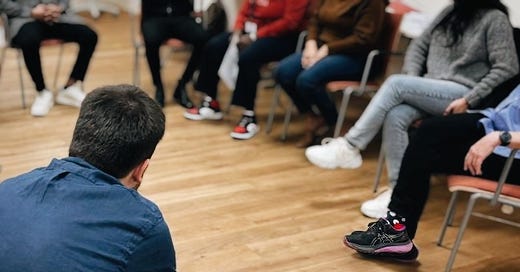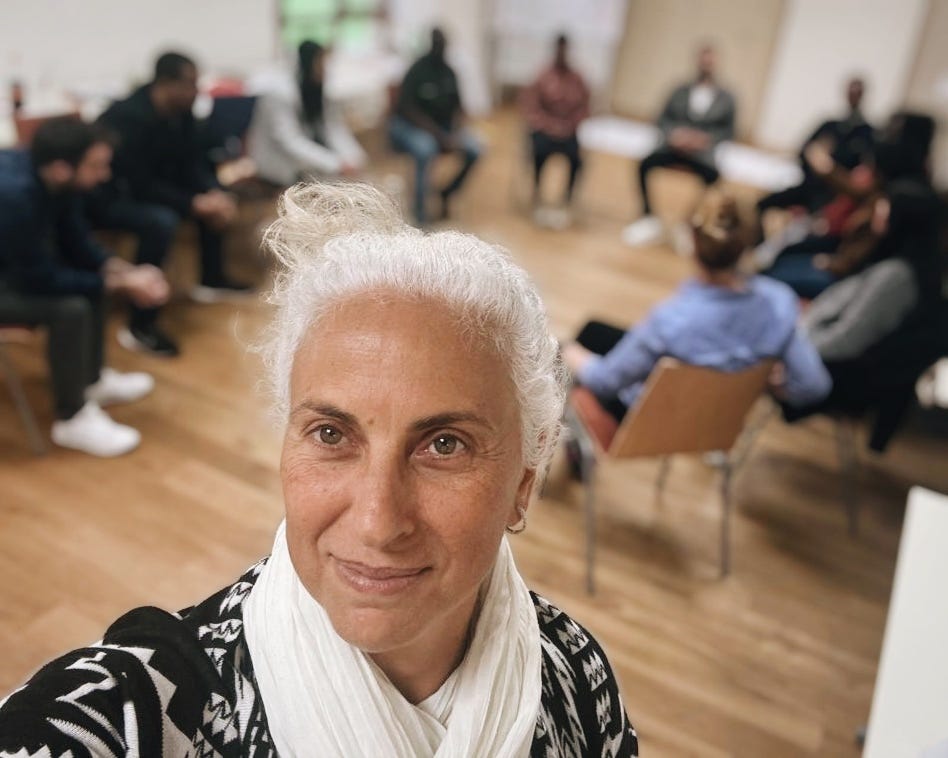When You Stay in the Room: Peace as a Daily, Trembling Choice
Daring to have hard conversations
Some questions don’t disappear after they’re asked.
They return.
They unsettle.
They sit inside the body, demanding more than opinion—demanding presence.
One such question was shared with me this week:
“Can you really make peace with someone who wants to kill you?”
It wasn’t rhetorical. It came from someone trying to hold the weight of too many realities—violence, grief, disbelief, and the stubborn, flickering hope that there might still be a way forward.
Beneath that question lived many others:
What does peace mean in the face of extremism, in the vacuum of hope?
How do Palestinians create a future free from both occupation and internal repression?
How does Israel step out of the logic of endless defense and into genuine security?
Should Ukrainians stop defending their land to pursue peace?
And how, in real terms, do these peace principles apply during a rocket attack, after October 7th, or when settler violence targets Palestinian families?
We didn’t reach for easy answers. We stayed in the room. And that act, in itself, became the ground for something deeper to emerge.
We spoke of Gaza—not as a strategic dilemma, but as a living hell for over two million people, many of them children, trapped under blockade for over 17 years. We named the unbearable violence, the trauma passed through generations, the false binaries that ask people to choose between survival and dignity. No statistic or death ratio can contain the full truth of what occupation does to the human spirit.
We spoke about Syria and Lebanon, about economic shifts, political interests, and regional dynamics. But none of it made sense without grounding in the story of Palestine—its dispossession, its resilience, its refusal to disappear.
We talked about 1948. About the Nakba, not just as a historical event but as an ongoing reality. Families still denied return. Villages still erased. Memory still criminalized. And we also named Jewish trauma—especially post-Holocaust. But healing one people’s trauma cannot require the dispossession of another.
We spoke about the claim that Israel is a colonial project. For some, this language provokes resistance. For Palestinians, it names a structure they have lived inside for over 75 years: settlement, displacement, military law, control without consent.
To call it colonial is not to erase Jewish connection to the land. It is to tell the truth about how the state was built—and what it cost.
Naming power structures is not the same as denying belonging. Part of peacebuilding is learning to sit with multiple truths—not as contradictions, but as the tension we’re called to transform.
The truth of ancestral trauma and the truth of ongoing occupation. The truth of deep Jewish indigeneity and the truth of Palestinian erasure. We cannot flatten one to justify the other. We must learn to hold them both—not as contradictions, but as the tension we’re called to transform.
We spoke about the forced exodus of Jews from Arab countries—how their pain has been politicized while often being neglected within Israel itself. And we named how Palestinians have been made to carry the burden for betrayals committed by Arab regimes that never truly stood for their liberation.
Religion also came up. Judaism, Islam, and Christianity—each containing deep wisdom, each distorted to serve empire and war. We saw how scripture is often used to defend supremacy rather than invite accountability.
And then, like so many of these conversations, we turned toward the personal.
I shared a moment from my own life—when I was excluded from a Jewish community in Strasbourg. It wasn’t theology that hurt. It was the experience of being shut out because of who I was, where I was from. That moment marked something in me—not as a wound I still carry, but as a memory that taught me what it feels like to be rejected not for your actions, but for your very being. It shaped how I understand belonging—and the longing that can fester in its absence.
He shared a story about an Emirati friend who had once refused to stay with a Jewish host family—only to return years later as part of their family. These stories remind us that hatred is rarely innate. It’s passed on. And so is healing.
This is where Peace Activation lives—not in abstract diplomacy, but in relational presence. Not in theory, but in the breath and the body. It begins when we stop performing identity and start witnessing truth.
Peace Activation is not a dialogue project. It is a long-term, trauma-informed practice. It is about creating the emotional, cultural, and systemic conditions for peace to take root—beginning with the choice to stay present when it’s easier to leave.
This shows up in our Peace Activation Gatherings—spaces where Palestinians, Israelis, and allies speak the unspeakable. Not to agree. But to feel, to grieve, to listen, to stay.
From there, we move into Peace Activation Workshops—possible sites of co-creation where youth, educators, artists, and community leaders can work together to imagine and build something new. These are not symbolic gestures. They are real spaces of possibility. Of repair. Of creation beyond collapse.
If we had the resources, we would build a Peace Activation Community—a permanent sanctuary near the Green Line. A place of intergenerational learning, cultural renewal, trauma healing, and visionary leadership. A living model of what peace looks like when it is practiced—not as ceasefire, but as culture.
Governments can support this work by funding it, protecting it, and making space for it to thrive. But whether they do or not, the work is already in motion.
And now, the story continues.
This week, I carry all of this with me to Paris, where I’ve been invited to join the Paris Peace Forum—a historic gathering focused on the Two-State Solution, regional security, and what it will take to end the cycle of violence.
I’m not going as a diplomat or politician. I’m going as someone who has chosen to stay in the room. As someone rooted in both loss and longing. As someone who believes that real peace doesn’t come from carefully worded declarations—it comes from the courage to be transformed by another’s truth.
At the forum, Peace Activation will offer what it always does: a trauma-informed, embodied perspective that honors pain without being consumed by it. That makes space for multiple truths. That invites us to move beyond identity performance and into relational repair.
I will carry with me the voices of those too often unheard. The grief of those buried beneath headlines. The quiet strength of those building, breath by breath, beneath rubble and resistance.
And when asked how peace might actually work, this is what I will say:
You stay in the room.
You speak what was once forbidden.
You listen to the truth that disrupts your certainty.
You resist the comfort of sides, and choose the integrity of complexity.
You name the pain—not to justify it, but to release its grip.
And you begin again.
Because peace is not a summit.
It’s not a speech.
It’s a daily, trembling choice.
And it’s already happening—in circles of truth, on ancestral land, and in the hearts of those refusing to hate.
If this moved something in you, share it. Let it reach those still wondering whether another future is possible.
This is The Other Narrative—woven not from neutrality, but from truth, repair, and the radical act of staying in the room.





